Editorial "CRC Press LLC"
Se han encontrado 13 Coincidencias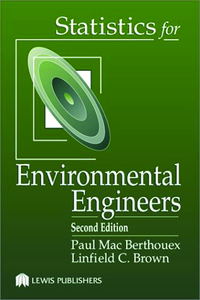
Statistics for Environmental Engineers
134 Visitas | 182 Descargas | 2013-10-03 20:02:30 | efirvida
There are many aspects of environmental problems: economic, political, psychological, medical, scientific, and technological. Understanding and solving such problems often involves certain quantitative aspects, in particular the acquisition and analysis of data. Treating these quantitative problems effectively involves the use of statistics. Statistics can be viewed as the prescription for making the quantitative learning process effective.
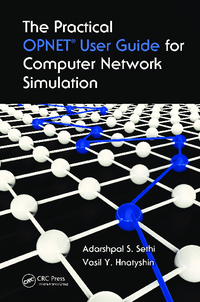
The Practical OPNET User Guide for Computer Network Simulation
Modelación y Simulación de Redes de Comunicaciones
80 Visitas | 130 Descargas | 2013-11-28 16:23:53 | fapaliza
Teachers of networking courses in universities constantly look for various new active learning tools for engaging students in classroom discussion, providing stu- dents with hands-on experiences, and getting students to become more interested in the subject area. OPNET software constitutes an excellent active learning tool that may help teachers achieve all these goals. In particular, OPNET software allows teachers to study and evaluate diverse networking systems with as simple or as complex topology as needed, illustrate various networking concepts, and show the students how the network performance changes under different conditions. It is no wonder that more than 500 universities worldwide* currently use OPNET network simulation software in teaching and research. This book is, to our knowledge, the rst text to provide a comprehensive descrip- tion of OPNET IT Guru and Modeler software and how to use this software for the simulation and modeling of computer networks. The book also includes a set of laboratory projects to help learn different aspects of the software.

Photovoltaic Systems Engineering, Second Edition
Engineering, Computing & Technology
58 Visitas | 74 Descargas | 2014-05-29 03:08:33 | raulito
The goal of the first edition of this textbook was to present a comprehensive engineering basis for photovoltaic (PV) system design, so the engineer would understand the what, the why and the how associated with electrical, mechanical, economic and aesthetic aspects of PV system design. The first edition was intended to educate the engineer in the design of PV systems so that when engineering judgment was needed, the engineer would be able to make intelligent decisions based upon a clear understanding of the parameters involved. This goal differentiated this textbook from the many design and installation manuals that are currently available that train the reader how to do it, but not why. Widespread acceptance of the first edition, coupled with significant growth and new ideas in the PV industry over the 3 years since its publication, along with 3 additional years of experience with PV system design and installation for the authors, has led to the publication of this second edition. This edition includes updates in all chapters, including a number of new homework problems and sections that cover contemporary system designs in significant detail. The book is heavily design-oriented, with system examples based upon presently available system components (2003). While the primary purpose of this material is for classroom use, with an emphasis on the electrical components of PV systems, we have endeavored to present the material in a manner sufficiently comprehensive that it will also serve the practicing engineer as a useful reference book.
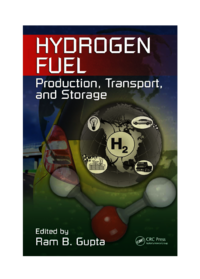
Hydrogen Fuel : Production, Transport, and Storage
58 Visitas | 50 Descargas | 2014-12-06 17:56:00 | raulito
The two most important environmental hazards faced by humankind today are air pollution and global warming. Both have a direct link with our current overdependence on fossil fuels. Pollutants produced from combustion of hydrocarbons now cause even more health problems due to the urbanization of world population. The net increase in environmental carbon dioxide from combustion is a suspect cause for global warming, which is endangering the Earth—the only known place to support human life. In addition, the import of expensive hydrocarbon fuel has become a heavy burden on many countries, causing political and economic unrest. If we look at the past 2000 years’ history of fuels, usage has consistently moved in the direction of a cleaner fuel: wood ? coal ? petroleum ? propane ? methane as shown on the next page. With time, the fuel molecule has become smaller, leaner in carbon, and richer in hydrogen. The last major move was to methane, which is a much cleaner burn than gasoline. Our future move is expected to be to hydrogen, which has the potential to solve both the environmental hazards faced by humankind. Through its reaction with oxygen, hydrogen intensely releases energy in combustion engines or quietly releases it in fuel cells to produce water as its only by-product. There is no emission of smoke, CO, CO2, NOx, SOx, or O3. In fact, the health costs for urban populations can be reduced by switching to hydrogen automobiles. Hydrogen can be produced from water using a variety of energy sources including solar, wind, nuclear, biomass, petroleum, natural gas, and coal. Since renewable energy sources (solar, wind, and/or biomass) are available in all parts of the world, all countries will have access to hydrogen fuel. Hence, a greater democratization of energy resources will occur. Also the use of solar, wind, or biomass in producing hydrogen does not add to environmental CO2. Before widescale use of hydrogen fuel can be accomplished, key technological challenges need to be resolved, including cost-effective production and storage of hydrogen. During the early adoption of hydrogen fuel, government incentives will be needed,
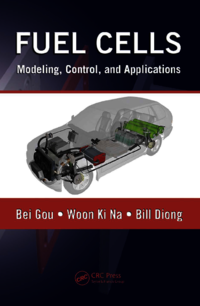
FUEL CELLS. Modeling, Control, and Applications
49 Visitas | 76 Descargas | 2014-12-06 17:58:23 | raulito
The present literature pays a lot of attention to the control design of fuel cell interfaces, while the research on control design for the fuel cell itself receives less attention than it should. This may be due to the complexities involved in control design. However, control is very important to fuel cell operation and effi ciency, and this book serves as an introduction to this topic. This book should be of interest to faculty, students, consultants, manufacturers, researchers, and designers in the fi eld of renewable energy, as it provides a detailed discussion on fuel cell modeling, analysis, and nonlinear control with simulation examples and test results. We assume its readers already have a fundamental knowledge of control theory and fuel cell chemical reactions.

BIOFUEL
80 Visitas | 113 Descargas | 2014-12-06 18:02:01 | raulito
Cellulose — in particular, cellulose in “lignocellulosic biomass” — embodies a great dream of the bioorganic chemist, that of harnessing the enormous power of nature as the renewable source for all the chemicals needed in a modern, biosciencebased economy.1 From that perspective, the future is not one of petroleum crackers and industrial landscapes fi lled with the hardware of synthetic organic chemistry, but a more ecofriendly one of microbes and plant and animal cells purpose-dedicated to the large-scale production of antibiotics and blockbuster drugs, of monomers for new biodegradable plastics, for aromas, fragrances, and taste stimulators, and of some (if not all) of the novel compounds required for the arrival of nanotechnologies based on biological systems. Glucose is the key starting point that, once liberated from cellulosic and related plant polymers, can — with the multiplicity of known and hypothesized biochemical pathways in easily cultivatable organisms — yield a far greater multiplicity of both simple and complex chiral and macromolecular chemical entities than can feasibly be manufactured in the traditional test tube or reactor vessel.
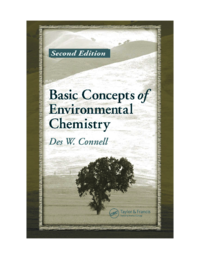
Basic Concepts of Environmental Chemistry
Basic Concepts of Environmental Chemistry, Second Edition provides a theoretical basis for the behavior and biological effects of natural chemical entities and contaminants in natural systems, concluding with a practical focus on risk assessment and the environmental management of chemicals.
63 Visitas | 75 Descargas | 2015-11-24 20:04:21 | AMorales
The text uses molecular properties such as polarity, water solubility, and vapor pressure as the starting point for understanding the environmental chemistry of various contaminants in soil, water, and the atmosphere. It explains biological processes such as respiration and photosynthesis and their relationship to greenhouse gases. The book then introduces environmental toxicology and describes the distribution, transport, and transformation of contaminants, including PCBs and dioxins, plastics, petroleum and aromatic hydrocarbons, soaps and detergents, and pesticides. The author highlights the relationship between specific chemical properties and their environmental and biological effects. Other topics discussed include partition behavior, fugacity, and genotoxicity, particularly involving carcinogens.

CORROSION SCIENCE and TECHNOLOGY
63 Visitas | 65 Descargas | 2015-12-08 03:45:43 | raulito
Engineering metals are unstable in natural and industrial environments. In the long term, they inevitably revert to stable chemical species akin to the chemically combined forms from which they are extracted. In that sense, metals are only borrowed from nature for a limited time. Nevertheless, if we understand their interactions with the environments to which they are subjected and take appropriate precautions, degradation can be arrested or suppressed long enough for them to serve the purposes required. The measures that are taken to prolong the lives of metallic structures and artifacts must be compatible with other requirements, such as strength, density, thermal transfer, and wear resistance. They must also suit production arrangements and be proportionate to the expected return on investment. Thus, problems related to corrosion and its control arise within technologies, but solutions often depend on the application of aspects of chemistry, electrochemistry, physics, and metallurgy that are not always within the purview of those who initially confront the problems. Corrosion is the transformation of metallic structures into other chemical structures, most often through the intermediary of a third structure, i.e., water and a first task is to characterize these structures and examine how they determine the sequences of events that result in metal wastage.

THE GREEN COMPUTING BOOK
75 Visitas | 60 Descargas | 2017-02-14 06:13:42 | raulito
In 1957, the Soviet Union launched the first Earth-orbiting artificial satellite—Sputnik I—into space. This singular event precipitated the birth of the space age and, more specifically, the U.S.–U.S.S.R. space race. If we fast forward 45 years, the year is 2002, and Japan unveils the first supercomputer that obliterates U.S. domination in supercomputing,?creating such a fervor that the event is dubbed Compute-nik and ignites an “arms race in supercomputing” in which the need for speed is paramount above all else and supercomputing (also referred to as high-performance computing or HPC) becomes increasingly mainstream, as illustrated in Figure 0.1 from the U.S. Council of Competitiveness, and as detailed in a report by the President’s Information Technology Advisory Committee (PITAC). However, this singular focus on speed as a performance metric arguably comes at the expense of other performance metrics, such as efficiency, reliability, and availability, to name a few. These “other” metrics are of particular interest to our Supercomputing in Small Spaces (SSS) project, which started in 2001, when being cool was “not cool.” Why? With the supercomputing community’s focus on speed, supercomputing nodes were not only becoming faster but also consuming and dissipating more power. By applying Arrhenius’s equation† to microelectronics or, more generally, computer hardware, every 10?C increase in temperature doubles the failure rate of a given system. This equation was supported by our own informal empirical data at the time, specifically a 128-node cluster that resided in a warehouse and failed approximately once perweek during thewinter months when the temperature inside the warehouse was 21–23?C and approximately twice per week during the summer months when the temperature was 30–32?C.

EnErgy EfficiEncy and rEnEwablE EnErgy
41 Visitas | 29 Descargas | 2017-02-14 07:06:29 | raulito
The goal of this handbook is to provide information necessary for engineers, energy professionals, and policy makers to plan a secure energy future. The time horizon of the handbook is limited to approximately 20 years because environmental conditions vary, new technologies emerge, and priorities of society continuously change. It is therefore not possible to make reliable projections beyond that period. Given this time horizon, the book deals only with technologies that are currently available or that are expected to be ready for implementation in the near future. Energy is a mainstay of an industrial society. As the population of the world increases and people strive for a higher standard of living, the amount of energy necessary to sustain our society is ever increasing. At the same time, the availability of nonrenewable sources, particularly liquid fuels, is rapidly shrinking. Therefore, there is general agreement that to avoid an energy crisis, the amount of energy needed to sustain society will have to be contained and, to the extent possible, renewable sources will have to be used. As a consequence, conservation and renewable energy (RE) technologies are going to increase in importance and reliable, up-to-date information about their availability, efficiency, and cost is necessary for planning a secure energy future.

Alternative Fuels for Transportation
60 Visitas | 76 Descargas | 2017-02-14 07:08:22 | raulito
Two problems currently confronting the world are the energy crisis and environmental pollution. Energy consumption in the world is increasing faster than its generation. It is estimated that the existing petroleum oil and natural gas reserves will be sufficient for only another few decades. The transportation sector and decentralized power generation completely depend upon petroleum products, particularly gasoline and diesel. The transportation sector is growing at a faster rate than reserves due to rapid technological development in the automotive industry and an increase in the use of personal vehicles in developed and developing countries. Thus the demand for petroleum accelerates the crude oil petroleum production peaks as well as its cost. Vehicle pollution has been a serious concern for the past few decades all over the world. Combustion products of petroleum fuels, such as carbon dioxide, are a major contributor to greenhouse gases. An increase in the concentration of greenhouse gases in the atmosphere will lead to global climate change. In the early 1960s, the United States initiated laws to control vehicle emissions and most other counties in the world have followed its lead. Moreover, the increasing operating cost of refineries to meet the latest emissions norms has put pressure on refining margins, and remains a problem converting refinery streams into products with acceptable fuel specifications. The combination of a short supply of fossil fuel reserves, environmental pollution, and volatility in crude oil prices has generated interest for using alternative fuels. In the long term, the role and interrelationship of alternative energy sources with other markets demand further attention and consideration. Renewable alternative fuels (i.e., biofuels) have low-net greenhouse gases; hence, many countries are promoting them as a part of their national plan to reduce greenhouse gases and to improve their energy security. Stringent emission standards have been enforced in many countries which has led to improvement in automotive technology and the use of alternative fuels like biofuels and gaseous fuels at an optimum blend. This book addresses the need for energy researchers, engineers (mechanical, chemical, and automobile), doctoral students, automotive power train researchers, vehicle manufacturers, oil industry researchers, and others interested in working on alternative fuel sources. Each chapter in the book contains the potential of the alternative fuels, production methods, properties, and vehicle tests, as well as their merits and demerits.

Technologies for Converting Biomass to Useful Energy: Combustion, gasification, pyrolysis, torrefaction and fermentation
139 Visitas | 40 Descargas | 2017-02-14 07:30:28 | raulito
The objective of this book series is to focus on practical solutions in the implementation of sustainable energy and climate protection projects. Not moving forward with these efforts could have serious social and economic impacts. This book series will help to consolidate international findings on sustainable solutions. It includes books authored and edited by world-renowned scientists and engineers and by leading authorities in in economics and politics. It will provide a valuable reference work to help surmount our existing global challenges.

SustainableWater Developments Resources, Management, Treatment, Efficiency and Reuse
75 Visitas | 63 Descargas | 2017-02-14 07:35:05 | raulito
This book was written as one of the “Sustainable Water Developments” book series. Realizing, however, thatwater, energy and food are the three pillars to sustain the growth of human population in the future, the book deals with all the above aspects with particular emphasis on water and energy. Despite the availability of several books on similar subject, this book is unique by including the results of research efforts mainly in the ASEAN and the Middle East Regions. With a large population of the ASEAN nations (around 300 million) and their rich natural resources, sustainable development of the region based on suitable utilization of the valuable resources will have a strong impact on the growth of the entire global economy. However, with limited land resources, inadequate energy supply and growing water stress, the region faces the challenge of providing enough water and energy to grow enough food for the burgeoning population. These issues and challenges in the water, energy and food sectors are interwoven in many complex ways and cannot be managed effectively without cross-sectorial integration. Luckily, the technologies are currently available to address all the above issues simultaneously, and the membrane separation technology is one of such key technologies. Therefore, it is no wonder that strong membrane research and development activities are now being undertaken in the ASEAN region. It is also needless to say that, as the primary supplier of the fossil fuel to the global market yet with scarce water resources, the production of drinking water and the rational management of energy by the nations in the Middle East is equally crucial to maintain the peace in the whole world. In this era of the global collaboration, it seems nowadays of primary importance to assemble the results of the individual research efforts in one place, thus promoting the networking among different research institutions in order to achieve the common goal of finding the solutions to the challenges we are facing. It was very fortunate therefore that the editors were successful to collect twenty eight papers; all related to water and energy, from the region as well the other parts of the world.
Contribuir
Usted puede contribuir con Libros UCLV, es importante para nosotros su aporte..
Contribuir